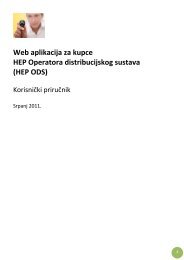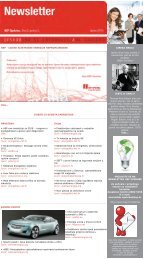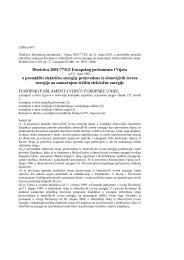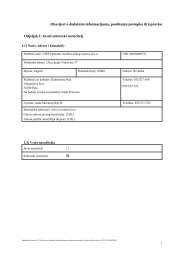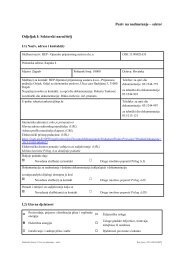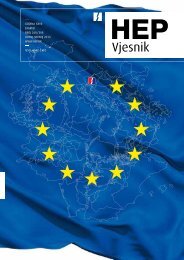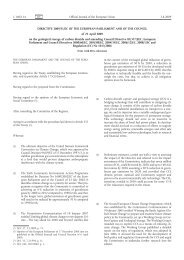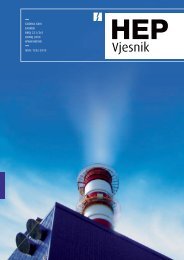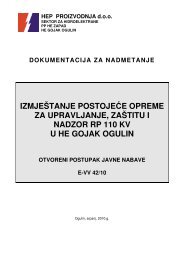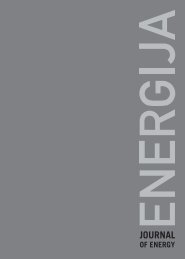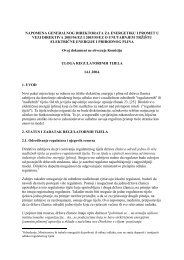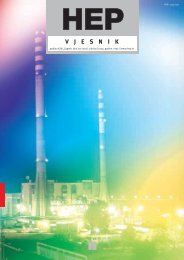Create successful ePaper yourself
Turn your PDF publications into a flip-book with our unique Google optimized e-Paper software.
S gospodarskog stajaliπta logika nameÊe da<br />
se prednost dâ specifiËnoj vrsti πtednje koja,<br />
ceteris paribus, ostvaruje isti cilj, ali uz niæe<br />
troπkove. Ipak, sloæeno je i vrlo skupo uËiniti<br />
inventuru svih moguÊih tehnologija koje na ovaj<br />
ili onaj naËin mogu dovesti do izvjesne uπtede<br />
te prikupiti pouzdane podatke o troπkovima<br />
koje takve specifiËne tehnologije nameÊu, da<br />
bi se mogla provesti popreËna kontrola koliËine<br />
uπteappleene energije i odgovarajuÊeg troπka. Sam<br />
pojam troπak moæe se tumaËiti i procjenjivati<br />
na razliËite naËine. Pored troπkova proizvodnje i<br />
troπkova instaliranja neke odreappleene tehnologije,<br />
ponekad moæe biti primjereno uraËunati i vanjske<br />
druπtvene troπkove (i/ili koristi) koje razvoj odreappleene<br />
tehnologije moæe donijeti u smislu poveÊanja<br />
zaposlenosti, razvitka domaÊe industrije itd.<br />
Ako je s jedne strane teπko meappleusobno usporeappleivati<br />
razliËita moguÊa rjeπenja koja daju<br />
istovjetne rezultate (nulti πtetni ekoloπki utjecaj),<br />
joπ je teæe utvrditi prioritete kad je rijeË o izvorima<br />
ili tipologiji postrojenja koja imaju razliËiti utjecaj<br />
na okoliπ. Naime, utjecaj na okoliπ definira se<br />
mnoæinom meappleusobno nehomogenih emisija koje<br />
imaju ponekad sasvim razliËite πtetne utjecaje.<br />
Odabrati jedan ili viπe πtetnih utjecaja i smatrati<br />
to pokazateljem sveukupnog πtetnog utjecaja<br />
podrazumijeva, meappleutim, definiranje sustava<br />
relativnih teæina temeljem kojeg se ocjenjuje<br />
veliËina emisije svake pojedine tvari u odnosu na<br />
one ostale.<br />
S razumno toËnom aproksimacijom moæe se<br />
utvrditi kako veÊinu πtetnog utjecaja koji nastaje<br />
djelovanjem elektroenergetskih postrojenja predstavlja<br />
atmosfersko oneËiπÊenje. Meappleutim, ne moæe<br />
se s jednakom sigurnoπÊu reÊi koji je oneËiπÊivaË<br />
πtetniji od ostalih pa kao takav zasluæuje veÊu<br />
pozornost i hitniju intervenciju kako bi se ostvarilo<br />
njegovo kratkoroËno i dugoroËno smanjenje.<br />
Glavni oneËiπÊivaËi u tom smislu svakako su NO x<br />
,<br />
SO x<br />
, Ëestice, stakleniËki plinovi i oni su tijekom<br />
ovih godina bili predmetom epidemioloπkog,<br />
agronomskog i kemijskog istraæivanja. UnatoË<br />
ostvarenom napretku, joπ je uvijek vrlo teπko<br />
precizno utvrditi stupanj opasnosti koji donosi<br />
svaki pojedini oneËiπÊivaË.<br />
Opseæna istraæivanja u studiji ExternE [3] provedena<br />
1995. i 1997. godine, koja danas predstavljaju<br />
moæda najvjerodostojniju i najpotpuniju sintezu<br />
stanja stvari na tom podruËju, kvantificiraju πtetni<br />
utjecaj izraæen u gospodarskim pokazateljima po<br />
emitiranoj jedinici oneËiπÊenja i to u istom redu<br />
veliËina kao i za krute Ëestice, sumporove okside<br />
i duπikove okside. Uz odreappleeni oprez kad je rijeË<br />
o ostvarenoj pouzdanosti u ovoj studiji, smatra se<br />
kako ocjene ExternE pruæaju prihvatljive podatke o<br />
aspects, there is particular emphasis on the fact that<br />
saved energy is equivalent to energy produced with<br />
zero negative environmental impact. From the conceptual<br />
and thermodynamic standpoints, two forms<br />
of saving (in consumption and production) are fully<br />
equivalent.<br />
From the economic standpoint, logic dictates that<br />
preference should be given to the specific type of<br />
saving which, all other things being equal, achieves<br />
the same goal but at lower cost. Nonetheless, it is<br />
complicated and very expensive to conduct an inventory<br />
of all the possible technologies that in this or<br />
that manner can lead to some savings and collect reliable<br />
data on the costs that such specific technologies<br />
impose, in order to implement transverse control<br />
of the amount of energy savings and the corresponding<br />
costs. The concept of cost can be interpreted and<br />
assessed in various ways. In addition to production<br />
costs and the installation costs of a specific technology,<br />
external social costs (and/or benefits) are sometimes<br />
calculated which can be incurred through the<br />
development of a specific technology in the sense of<br />
increased employment, the development of domestic<br />
industry etc.<br />
If from the one side it is difficult to compare the<br />
various possible solutions that yield identical results<br />
(zero detrimental environmental impact), it is even<br />
more difficult to determine priorities when speaking<br />
of sources or the typology of facilities that have various<br />
environmental impacts. Environmental impact is<br />
defined by a multitude of mutually non-homogeneous<br />
emissions that sometimes have various detrimental<br />
impacts. To choose one or more detrimental impacts<br />
and to consider this as an index of the overall detrimental<br />
impact implies, however, the definition of a<br />
system of relative weights, on the basis of which the<br />
amounts of emissions of each individual substance<br />
can be evaluated in comparison to others.<br />
With reasonably precise approximation, it is possible<br />
to determine that the majority of the detrimental<br />
effects that occur due to the operation of electrical<br />
energy plants involve air pollution. However, it is not<br />
possible with equal certainty to say which pollutant<br />
is more detrimental than the others and as such<br />
warrants greater attention and more urgent intervention<br />
in order to achieve its short-term or long-term<br />
reduction. The main pollutants in this sense are<br />
certainly NO x<br />
, SO x<br />
, particles and greenhouse gases,<br />
which during these years were the subject of epidemiological,<br />
agricultural and chemical investigations.<br />
Despite the progress achieved, it is still very difficult<br />
to determine the precise degree of hazard posed by<br />
an individual pollutant.<br />
An extensive investigation in the study ExternE [3]<br />
conducted in the years 1995 and 1997, which today<br />
333<br />
De<br />
Paoli, L., ViπkoviÊ, A., Javna potpora razvitku obnovljivih..., Energija, god. 56(2007), br. 3., str. 328∑345<br />
De Paoli, L., ViπkoviÊ, A., Public support for the development..., Energija, vol. 56(2007), No. 3, pp. 328∑345



